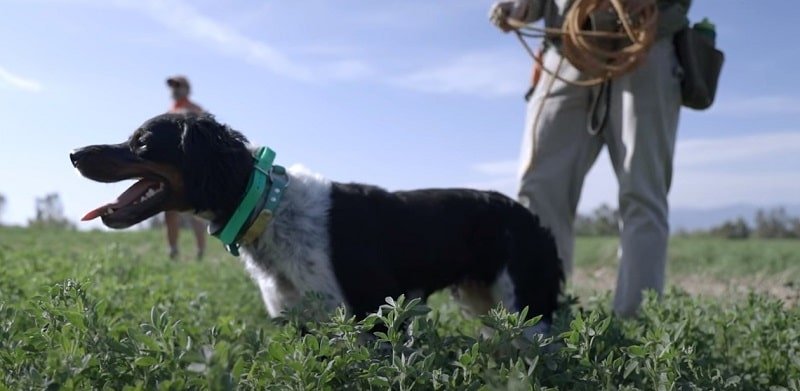Brittany dogs are like small children, they have tons of energy, and they will demand that you play with them all the time. Daily walks are not enough to satisfy these dogs’ need for activity. They want you to engage in playtime, or they are not happy.
Brittany spaniels are a high-energy dog breed, but they generally calm down as they approach adulthood, so just before they are 12 months old, however, only slightly. Hyperactivity is part of their nature throughout their entire lives. These dogs can calm down indoors, but they will need to let off steam outdoors.
If you own a rambunctious Brittany Spaniel, undoubtedly, you want to explore ways to help your dog calm down. In this article, let’s explore ways of assisting owners in coping with such a dog. To better understand Brittany Spaniel, it helps to get a clearer picture of their personality and their breeds’ purpose.
Are Brittany Spaniels Hyper?
The Brittany was initially bred as a hunting dog that originated in Brittany, France. It’s uncertain when this dog came to be, but the breed was immortalized in tapestries and paintings from the 17th century. Those artworks depict hunting scenes.
The Brittany Spaniel is also recorded in a hunting description from 1850 and written by Reverend Davies. His notes describe the breed as excellent retrievers and pointing dogs.
Brittany Spaniels are indeed a hyper breed. Their temperament is like that of a setter or pointer than a spaniel. They may have the appearance of a spaniel, but they have the spirit of a hunting dog. Hunting dogs have boisterous personalities, as it goes with the territory.
Brittany Spaniels desperately need an outlet for their energy. It would help if you took them out for long walks, hiking in the woods, and swimming. They need lots of engagement from their owners, as they thrive on the attention you give them.
An inactive lifestyle will only lead to excessive barking, hyperactivity, and destructive chewing. You must be sure that you can provide sufficient exercise and mental stimulation.
Aside from providing enough exercise, you might also consider enrolling your Brittany Spaniel in obedience training, tracking, and agility.
How Do You Calm A Brittany Spaniel?
1. Don’t let him freely roam around your home
When you first bring your tiny buddy home, you must control his movements in your house. This means that you don’t allow him to wander around your house freely; he must understand that it is a privilege he must gradually earn.
Only when he is 100% housebroken, has learned all the rules, and is calm in your home can he have more liberty. Ensure that your home is puppy-proof, making sure that he is close to you at all times, even if that means keeping him on a leash.
If your dog isn’t housebroken, you need to keep him in a pen or crate when you’re busy and can’t interact with him.
2. Encourage calmness
You must instill both mental and physical calmness in your puppy. When you’re not with him, you must keep him safely confined to a pen or a crate.
Teach Yes and No. He must learn to walk nicely and wait at gates and doors rather than rushing through. It would be best if you taught him the Sit and Stay commands.
When your Brittany puppy disobeys your commands, correct him, however, gently. If you are too harsh with him, he will become more fearful and difficult, as these dogs are sensitive.
Ensure that you and your household are calm, and be mindful not to have loud music playing or the TV blaring
3. Using the reward system
You can use rewards such as a toy or treat as an incentive for your puppy to obey your commands. Brittany Spaniels are known to jump on people, bark, and chase other animals. Do not reward such behavior; instead, correct your dog; be firm but not harsh.
When your buddy displays good behavior such as standing still when you brush him, going to the bathroom in the right place, and treating guests politely, you must reward such behavior and offer praise. Offer a treat or a toy and lots of praise.
4. Provide daily opportunities for exercise and activity
It would be best to equip your new family member with an active lifestyle to channel their boundless energy. This dog breed is excitable, but they have many excellent traits that need nurturing to bring out their best.
You can get your Brittany Spaniel to calm down indoors eventually, but you must tire out your buddy. We are talking about at least two walks a day for about thirty minutes.
Other activities like swimming, running, hiking, and playing fetch will exhaust him so much that he is sure to be calm at home.
5. Practice early socialization
Brittany Spaniels can become excellent family pets that are polite and gentle with everyone, including other animals and strangers; however, they need early socialization.
Your Brittany puppy needs plenty of exposure to people, other dogs, unfamiliar sights, and noises from day one. This will nurture your dog’s softness without making him shy, fearful, and overall unbearable to live with.
You can bring your Britt to a local dog park; naturally, it will be hard at first. Your puppy will be very nervous. Initially, bring your dog to the park, and if he can only handle a few minutes at a time, allow it.
You can gradually increase your time at the park, use your leash to control your dog, and stop him from attacking people and other dogs.
Use treats to reward his good behavior, encouraging him to keep up the good work. Eventually, he will love the dog park and seeing people and other dogs.
6. Be the leader
You must command respect from your puppy from the day you bring him home. Your Brittany Spaniel must see you as the leader of the pack.
Dogs in the role of the alpha don’t enjoy being in charge; it causes them a lot of stress, they prefer to be followers. But they will take over if you don’t step up and take control.
You need to prove yourself as a calm, confident leader. You can show authority by walking into a room ahead of your dog, eating your meals before your dog, and generally showing your dog that he doesn’t come first. Your four-legged friend will be happier and more at peace because he has an owner he can trust and look up to.
Will My One Year Old Dog Ever Calm Down?

Many vets and dog behaviorists get this type of question regularly, with varying ages. If you’re new to this dog breed, you may expect your Brittany Spaniel to calm down when he is 12 months of age or whenever he reaches his full size – between 12 to 16 months.
A perfectly healthy Brittany Spaniel will reach physical maturity and meet all his physical milestones. However, mental maturity isn’t always guaranteed.
Brittany Spaniels are often hyperactive, playful, overly clingy, and struggle with social anxiety throughout their lives.
Many Britts seem to calm down only slightly with age, with some owners reporting a calmer dog by 10 or 11 months of age.
This doesn’t mean their dogs have mentally matured; it means that their dogs’ movements are more controlled and sophisticated. Your Brittany Spaniel won’t do so much romping but more deliberate jumping and running.
Knowing that this is a high-energy dog breed, as their owner, you must match their energy. An owner of such a vibrant dog must love the outdoors and enjoy running, jogging, hiking, and walking.
Exercise is essential, but discipline in the home is equally important. If you fail to gently and lovingly discipline your dog, he won’t listen to you in the long term.
He will be unpleasant, displaying unwanted behavior like barking, digging, chewing, jumping on people, etc.
If your Brittany Spaniel badly behaves at home, you need to start nipping it in the bud now. Please don’t be harsh with him; there is no need to shout or call him names.
When you catch your dog doing something wrong, say no firmly, clap your hands loudly to get his attention. If you usually give him treats, no more, he needs to know that treats are to be earned.
Final Thoughts
The Brittany Spaniel temperament is very like that of a hunting dog. This breed is intelligent, loving, playful, curious, loyal, and generally everything you would expect of a hunting dog. However, be aware that you will be kept busy.
Do not get a Brittany Spaniel expecting it to calm down at a certain age; they are biologically predisposed to being high-energy.
However, be intentional about bringing calm into your dogs’ life. Create a harmonious environment in your home, and make sure that you are providing sufficient exercise opportunities.
If you take the necessary steps to raise a balanced, polite, well-adjusted Brittany Spaniel, you will have a best friend who is excellent company outdoors and in your home.
Table Of Content
- Are Brittany Spaniels Hyper?
- How Do You Calm A Brittany Spaniel?
- Will My One Year Old Dog Ever Calm Down?
from Pet Dog FAQ https://www.petdogfaq.com/what-age-do-brittany-spaniels-calm-down/

